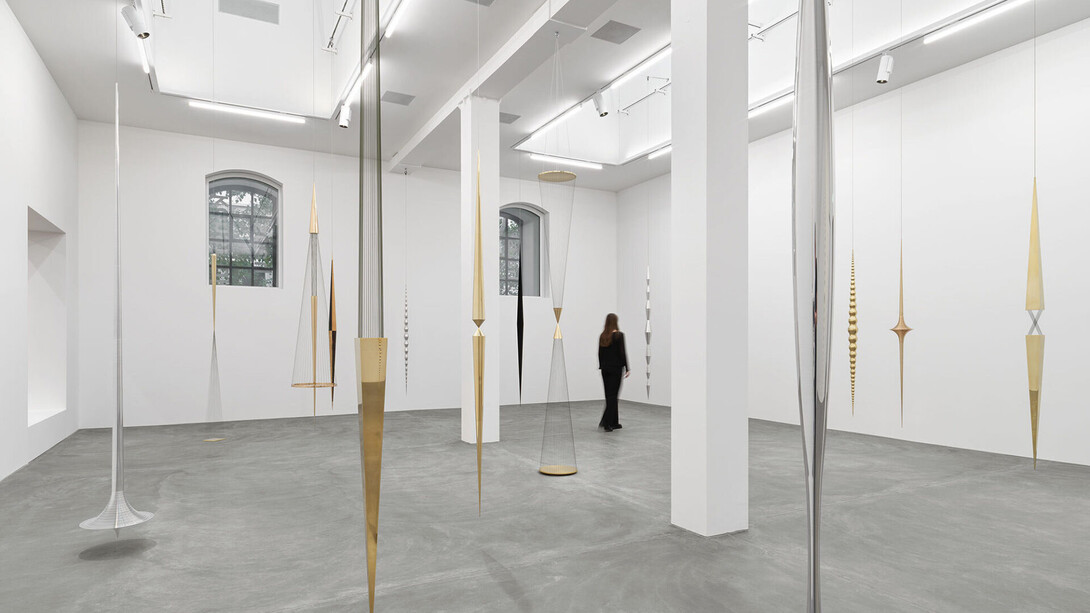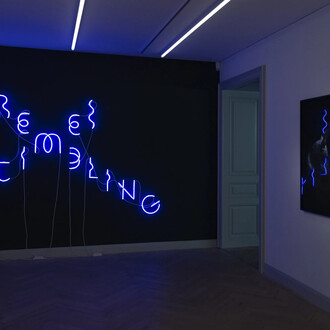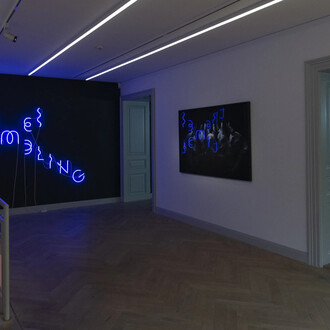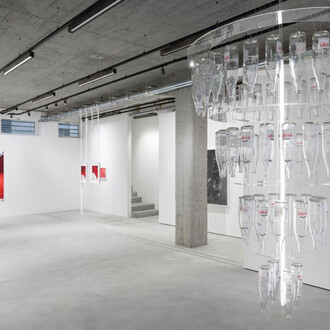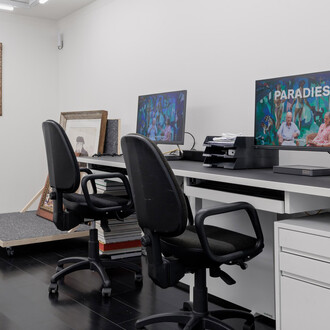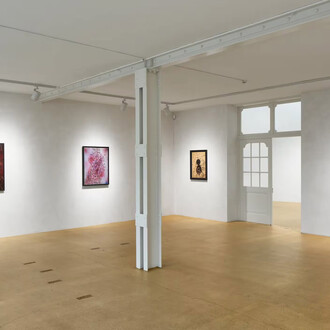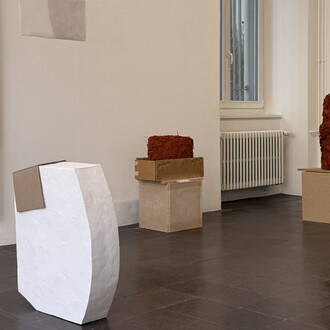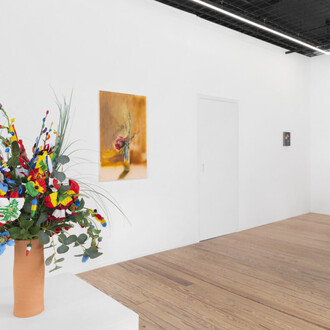In 2025, the Zurich Art Prize, awarded annually by Museum Haus Konstruktiv and Zurich Insurance Company Ltd, goes to Brazilian artist Artur Lescher (b. 1962 in São Paulo, where he lives and works). This makes him the 18th winner of the renowned and highly endowed award.
Artur Lescher has been working as an artist since the mid-1980s and has made a name for himself in the art world with his sculptures. His oeuvre is characterised by intensive engagement with the specific properties and potential of materials, such as brass, wood and copper, among others. The sculptures exude minimalist elegance, yet despite their perfect surfaces and often cool, pared-down aesthetics, they come across as charged, alive and in motion – an effect that is particularly striking in his seemingly free-floating objects.
The first exhibition room allows this tension between strict form and subtle vitality to be experienced. Here, Lescher displays a multitude of Pendulums: These slender, stele-like objects attached to the ceiling give the impression that they are suspended by an anti-gravitational force. Associations with stellar constellations are reinforced by the shiny materials. In the piece V sagittae, Lescher creates a monument to the Sagitta constellation’s eponymous binary star, which is inconspicuous in itself, but is expected to erupt as a nova around the year 2083 and shine as brightly as Sirius, the brightest star in the night sky. This cosmic reference opens up a dimension of temporality and transformation, incorporating Lescher’s works into a greater narrative, beyond the visible.
Lescher’s artworks can be presented as individual pieces, but when viewed together, they form their own cosmos – or, indeed, an ‘entangled field’: This term is commonly used in quantum physics to describe a state in which several particles are so directly interconnected that they can no longer be described independently of one another. With his manner of artistic correlation, Lescher lends the space a haunting and poetic quality that elevates his works above pure aesthetics, to a metaphorical level.
In view of the aforementioned qualities, Lescher’s work can be positioned within a sculptural tradition that combines modernity with fundamental, sometimes archaic themes and enriches it with an animistic dimension. Parallels can be drawn with pieces by Constantin Brâncuși, the oeuvre of Louise Bourgeois (especially her steles) and Alberto Giacometti’s early surrealist work. And this is precisely where Lescher sets himself apart from pragmatic minimal art: While minimal art focuses on reduction and pragmatism, Lescher breathes life into the perfection of the geometric language of forms via references to mythology.
Lescher explores his material and tests its inherent possibilities with an obvious affinity for the world of technology and industrial design. At the same time though, he emphasises the mythological significance of certain materials and material properties, as well as their connection to the forces of nature. It is of central importance to him, for example, that the more flexible, soft copper is linked to the goddess Venus, while the heavy, dark iron represents Hephaistos. This attribution of symbolic meaning is combined with a deep respect for the physical properties of the substances: Heaviness, density, resistance or malleability are not overcome, but integrated into the aesthetic logic of the works.
A glance at Lescher’s sketchbook reveals not only designs for flying sculptures that defy gravity, but also birds of all kinds. In his oeuvre, there is no strict separation between art, nature and mythological or metaphysical matters. Such openness was also typical of Brazilian neoconcretismo in the 1960s, while reason was central to the concepts of European constructivist-concrete art.
Lescher himself summarises his references to art history as follows: “My engagement with neoconcretismo [...] includes studying works by artists like Hélio Oiticica and Lygia Clark, but also concretists such as Waldemar Cordeiro, Geraldo de Barros and Max Bill. In this context, Manifesto neoconcreto [published in Rio de Janeiro in 1959] is a key point of reference, as is the study of the common denominators of Russian constructivism and neoconcretismo.”
The artist’s decision to send visitors through the parallel exhibition Concrete art / Neoconcretismo before they enter the second room of his exhibition underscores the context and origins of his work. Here, references, links and relationships between the artworks, as well as references to art history, manifest themselves. For instance, the possible readings of the exhibition’s title Entangled fields are multi-layered.
Flanked by the wall display A chronicle of concrete art in Brazil, which provides a historical overview of how Brazilian and European concretists have influenced each other, Lescher presents Pendulum (1998), his earliest work in the exhibition. A nod to the aspect of time, to the passing of time, to history. However, a pendulum in a resting position also accentuates the here and now.
Lescher’s approach to architecture is made clear in Zwischen den zeilen (Between the lines), a site-specific piece, created specially for Museum Haus Konstruktiv in the third exhibition room. As if to measure the space, two lines comprising a multitude of red nylon threads run along the exhibition’s walls and floor. This minimal intervention emphasises the volume of the space, while making it appear light and floating. Associations with string instruments, strings or staves bring the theme of sound and music into play, turning the exhibition space into a sound space.
Lescher’s sculptures do not just fit into the space, but also interact with it. The space becomes an integral component of the sculptures, enhancing their presence. This ability to respond to the architecture of his respective exhibition spaces is what prompted the jury to award Lescher the Zurich Art Prize.
Lescher can look back on numerous international solo and group exhibitions. He has had solo shows at Farol Santander in Porto Alegre (2022), Pinacoteca in São Paulo (2019), and Palais d’Iéna in Paris (2017), for example. He has participated in group exhibitions at places such as Giza in Egypt (as part of a cultural project in 2023), at LagoAlgo in Mexico City (2022) and at Mana Contemporary in Jersey City (2016), for instance. Works by Artur Lescher are included in the collections of the following institutions, among others: MALBA in Buenos Aires, the Museum of Fine Arts Houston, the Philadelphia Museum of Art, the Buffalo AKG Art Museum, Biblioteca Luís Ángel Arango in Bogotá, Pinacoteca do Estado de São Paulo, and Museu de Arte Moderna de São Paulo.
(The Zurich Art Prize is part of Zurich Insurance Company Ltd’s commitment to culture)
